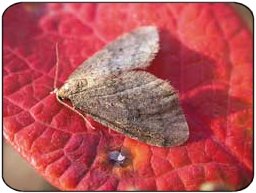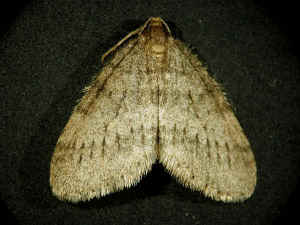|
==============================================================================
TOPIC: winter moth?
http://groups.google.com/group/entstrees/browse_thread/thread/b8ea34bf9db471f5?hl=en
==============================================================================
== 1 of 1 ==
Date: Wed, Dec 5 2007 1:13 pm
From: doug bidlack
 |

Figure 2 Adult male winter moth.
Photo: Bob Childs, University of Massachusetts |
Elisa,
Winter moths were introduced into North America twice
before being found in the eastern US. They were first
documented in Nova Scotia in the 50's and then in the
pacific NW in the 70's. They were first noticed in
the eastern US by Deborah Swanson of UMass extension.
She lives and works in Plymouth County and she was the
first to question that this might be an exotic species
rather than the common and very similar Fall
Cankerworm. Winter Moth has been found as far north
as the south coast of Maine, as far south as
Connecticut, and as far west as Worcester, MA. You
mentioned that they feed on oaks and this sorta
surprised me because I had mostly noticed it
defoliating maples here in southeastern MA. When I
read the info tha UMass has online about this species,
they mention that it preferred northern red oak to red
maple up in Nova Scotia, but that most reports here in
southeastern Massachusetts seem to indicate that it
prefers maples. They suggest that this may simply be
due to timing of leaf-out here as opposed to Nova
Scotia, since the larvae begin feeding quite early in
the season. The good news is that there appears to be
a good biological control for winter moth. It is a
european tachinid fly from Europe known as Cyzenis
albicans. Tachinids are a very large family of
parasitic flies that usually attack larval moths,
caterpillars, sawflies and beetles. Apparently it has
been effective at controllong winter moth populations
in Nova Scotia as well as the pacific northwest. If
you want to find out more just google 'winter moth
massachusetts'. UMass has some good info on this
species.
Doug
--- Elisa Campbell <campbell@oit.umass.edu> wrote:
>
> Hi,
> what do people know about winter moth and its spread
> in Masschusetts (probably also other parts of southeaster
New
> England)? I've heard they have killed oaks all over
Fall
> River, etc. and have spread to Natick or that vicinity.
>
> Elisa
==============================================================================
TOPIC: winter moth?
http://groups.google.com/group/entstrees/browse_thread/thread/b8ea34bf9db471f5?hl=en
==============================================================================
== 1 of 2 ==
Date: Fri, Dec 7 2007 6:14 pm
From: "Steve Galehouse"
This is an interesting thread--
Today, in N Ohio, I saw a grey-tan moth, with a wingspan of perhaps
an
inch, flitting along happily in 34F temp. Could this be the same
critter?
Steve
== 2 of 2 ==
Date: Fri, Dec 7 2007 8:57 pm
From: James Parton
Steve, ENTS,
In my younger days I used to study lepidoptera closely. I hatched
them
from eggs. Collected caterpillars & fed them until they pupated
&
turned to adults. I have even mounted them in display mounts. This
is
one moth I have not seen but I have seen ones that are similar, like
the Fall Cankerworm. What makes this one so unique is its winter
active habit. I have many photos of moths & butterflies. The
streetlight outside my home makes a really good moth magnet. I have
nice photos of Luna, Cecropia, Prometheus, Polyphemus & Clymene
moths
among many others. This time of year there is generally nothing to
be
seen around the light. I will keep an eye out on it for Winter Moth.
Most moths I like, but this one has too much negative impact on
trees.
That is true of many introduced species.
Here are two links on Winter Moth.
http://lakewhatcom.wsu.edu/gardenkit/UnWantedPests/WinterMoth.htm
http://en.wikipedia.org/wiki/Winter_Moth
James Parton
==============================================================================
TOPIC: winter moth?
http://groups.google.com/group/entstrees/browse_thread/thread/b8ea34bf9db471f5?hl=en
==============================================================================
== 1 of 1 ==
Date: Sun, Dec 9 2007 8:26 am
From: doug bidlack
Steve,
It's certainly possible. Winter moth adults are
common around lights in November and December. You
really need to catch one and then ID it. Hopefully it
is something else. There are a surprising number of
insects that emerge during the winter months,
including moths. There are also many caddisflies that
emerge at this time of year. Caddisflies are in the
order Trichoptera which is the most closely related
order to the moths and butterflies (Lepidoptera).
Most people would easily mistake a caddisfly for a
moth.
The coolest experience I ever had with a winter
caddisfly was in the northwestern lower peninsula of
Michigan during Christmas vacation several years ago.
Something like 8 feet of snow fell within a week and
my wife and I went out snowshoeing along the Jordan
River valley. Near the end of that hike we saw, and
managed to capture, a nice, large caddisfly. When my
dad picked us up I asked him to take us to bar near a
ski hill. I asked the bartender for the strongest
stuff he had. I always wanted to do that. Anyway, I
think he was a little suspicious, but when I told him
why I wanted the alcohol he was quite amused. I think
he gave me 151 proof rum. Perfect for preserving
caddisflies. It turned out to be an infrequently
collected species, but probably just because it only
emerges in the winter and few people collect them.
Doug
|